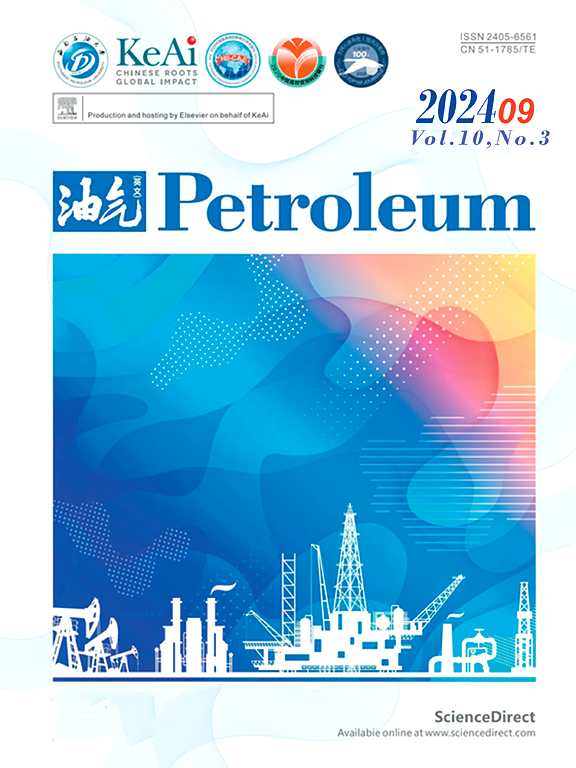Study on rapid construction of microemulsion system based on EACN of crude oil measured by the direct method
IF 3.5
Q2 ENERGY & FUELS
引用次数: 0
Abstract
The purpose of this study is to delineate the applicability of the direct method for determining the equivalent alkane carbon number (EACN), a crucial parameter in the hydrophilic-lipophilic deviation (HLD) theory, and to validate the efficacy of microemulsion systems formulated using this theory. The workload associated with constructing microemulsion systems can be substantially minimized through the application of the HLD theory, yet the accuracy and efficiency of this approach necessitate verification. Notably, the scope of application for the direct method in measuring EACN remains ambiguous. To address this, three different crude oil samples were analyzed, with their EACN values measured using the direct method. Subsequently, based on these measurements, microemulsion systems were screened and constructed according to the HLD theory. Adaptability experiments, interfacial tension assessments, and core displacement experiments were conducted to evaluate the system’s performance and its capacity to enhance oil recovery. The results indicate that the direct method has limitations in measuring the EACN of crude oil, particularly for heavy oils with complex compositions, but it is suitable for light oils with simpler compositions. Furthermore, the core displacement experiment revealed that for light oil from Xinghua Oilfield, the formulated system achieved a notable increase in recovery by 15.44%, demonstrating a significant enhancement in oil recovery.
基于直接法测得原油EACN的微乳体系快速构建研究
本研究的目的是描述确定等效烷烃碳数(EACN)的直接方法的适用性,EACN是亲水-亲脂偏差(HLD)理论中的一个关键参数,并验证使用该理论制定的微乳液体系的有效性。通过应用HLD理论,可以大大减少与构建微乳液系统相关的工作量,但该方法的准确性和效率需要验证。值得注意的是,测量EACN的直接方法的应用范围仍然不明确。为了解决这个问题,研究人员分析了三种不同的原油样品,并使用直接法测量了它们的EACN值。随后,基于这些测量结果,根据HLD理论筛选和构建微乳液体系。通过适应性实验、界面张力评估和岩心位移实验来评估该体系的性能及其提高采收率的能力。结果表明,直接法测定原油的EACN有一定的局限性,特别是对成分复杂的重油,但适用于成分简单的轻质油。岩心驱替实验表明,对于兴化油田的轻质油,该配方体系的采收率提高了15.44%,明显提高了采收率。
本文章由计算机程序翻译,如有差异,请以英文原文为准。
求助全文
约1分钟内获得全文
求助全文
来源期刊

Petroleum
Earth and Planetary Sciences-Geology
CiteScore
9.20
自引率
0.00%
发文量
76
审稿时长
124 days
期刊介绍:
Examples of appropriate topical areas that will be considered include the following: 1.comprehensive research on oil and gas reservoir (reservoir geology): -geological basis of oil and gas reservoirs -reservoir geochemistry -reservoir formation mechanism -reservoir identification methods and techniques 2.kinetics of oil and gas basins and analyses of potential oil and gas resources: -fine description factors of hydrocarbon accumulation -mechanism analysis on recovery and dynamic accumulation process -relationship between accumulation factors and the accumulation process -analysis of oil and gas potential resource 3.theories and methods for complex reservoir geophysical prospecting: -geophysical basis of deep geologic structures and background of hydrocarbon occurrence -geophysical prediction of deep and complex reservoirs -physical test analyses and numerical simulations of reservoir rocks -anisotropic medium seismic imaging theory and new technology for multiwave seismic exploration -o theories and methods for reservoir fluid geophysical identification and prediction 4.theories, methods, technology, and design for complex reservoir development: -reservoir percolation theory and application technology -field development theories and methods -theory and technology for enhancing recovery efficiency 5.working liquid for oil and gas wells and reservoir protection technology: -working chemicals and mechanics for oil and gas wells -reservoir protection technology 6.new techniques and technologies for oil and gas drilling and production: -under-balanced drilling/gas drilling -special-track well drilling -cementing and completion of oil and gas wells -engineering safety applications for oil and gas wells -new technology of fracture acidizing
 求助内容:
求助内容: 应助结果提醒方式:
应助结果提醒方式:


